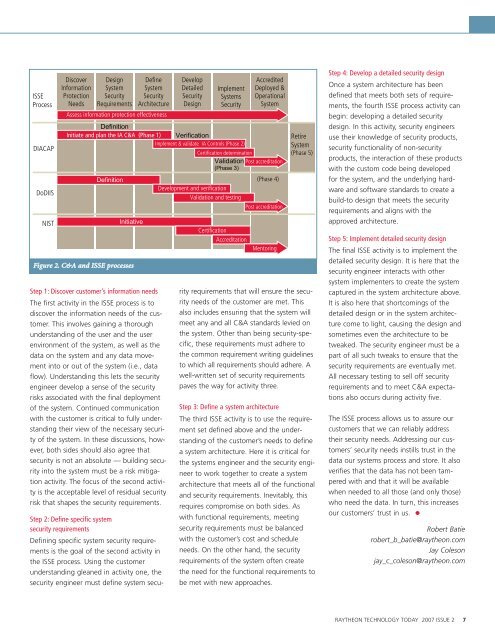2007 Issue 2 - Raytheon
2007 Issue 2 - Raytheon
2007 Issue 2 - Raytheon
You also want an ePaper? Increase the reach of your titles
YUMPU automatically turns print PDFs into web optimized ePapers that Google loves.
ISSE<br />
Process<br />
DIACAP<br />
DoDIIS<br />
NIST<br />
Discover<br />
Information<br />
Protection<br />
Needs<br />
Design<br />
System<br />
Security<br />
Requirements<br />
Assess information protection effectiveness<br />
Definition<br />
Initiate and plan the IA C&A (Phase 1) Verification<br />
Implement & validate IA Controls (Phase 2)<br />
Certification determination<br />
Validation Post accreditation<br />
(Phase 3)<br />
Definition<br />
Initiative<br />
Figure 2. C&A and ISSE processes<br />
Define<br />
System<br />
Security<br />
Architecture<br />
Step 1: Discover customer’s information needs<br />
The first activity in the ISSE process is to<br />
discover the information needs of the customer.<br />
This involves gaining a thorough<br />
understanding of the user and the user<br />
environment of the system, as well as the<br />
data on the system and any data movement<br />
into or out of the system (i.e., data<br />
flow). Understanding this lets the security<br />
engineer develop a sense of the security<br />
risks associated with the final deployment<br />
of the system. Continued communication<br />
with the customer is critical to fully understanding<br />
their view of the necessary security<br />
of the system. In these discussions, however,<br />
both sides should also agree that<br />
security is not an absolute — building security<br />
into the system must be a risk mitigation<br />
activity. The focus of the second activity<br />
is the acceptable level of residual security<br />
risk that shapes the security requirements.<br />
Step 2: Define specific system<br />
security requirements<br />
Defining specific system security requirements<br />
is the goal of the second activity in<br />
the ISSE process. Using the customer<br />
understanding gleaned in activity one, the<br />
security engineer must define system secu-<br />
Develop<br />
Detailed<br />
Security<br />
Design<br />
Implement<br />
Systems<br />
Security<br />
Development and verification<br />
Validation and testing<br />
Certification<br />
Accreditation<br />
Accredited<br />
Deployed &<br />
Operational<br />
System<br />
(Phase 4)<br />
Post accreditation<br />
Mentoring<br />
Retire<br />
System<br />
(Phase 5)<br />
rity requirements that will ensure the security<br />
needs of the customer are met. This<br />
also includes ensuring that the system will<br />
meet any and all C&A standards levied on<br />
the system. Other than being security-specific,<br />
these requirements must adhere to<br />
the common requirement writing guidelines<br />
to which all requirements should adhere. A<br />
well-written set of security requirements<br />
paves the way for activity three.<br />
Step 3: Define a system architecture<br />
The third ISSE activity is to use the requirement<br />
set defined above and the understanding<br />
of the customer’s needs to define<br />
a system architecture. Here it is critical for<br />
the systems engineer and the security engineer<br />
to work together to create a system<br />
architecture that meets all of the functional<br />
and security requirements. Inevitably, this<br />
requires compromise on both sides. As<br />
with functional requirements, meeting<br />
security requirements must be balanced<br />
with the customer’s cost and schedule<br />
needs. On the other hand, the security<br />
requirements of the system often create<br />
the need for the functional requirements to<br />
be met with new approaches.<br />
Step 4: Develop a detailed security design<br />
Once a system architecture has been<br />
defined that meets both sets of requirements,<br />
the fourth ISSE process activity can<br />
begin: developing a detailed security<br />
design. In this activity, security engineers<br />
use their knowledge of security products,<br />
security functionality of non-security<br />
products, the interaction of these products<br />
with the custom code being developed<br />
for the system, and the underlying hardware<br />
and software standards to create a<br />
build-to design that meets the security<br />
requirements and aligns with the<br />
approved architecture.<br />
Step 5: Implement detailed security design<br />
The final ISSE activity is to implement the<br />
detailed security design. It is here that the<br />
security engineer interacts with other<br />
system implementers to create the system<br />
captured in the system architecture above.<br />
It is also here that shortcomings of the<br />
detailed design or in the system architecture<br />
come to light, causing the design and<br />
sometimes even the architecture to be<br />
tweaked. The security engineer must be a<br />
part of all such tweaks to ensure that the<br />
security requirements are eventually met.<br />
All necessary testing to sell off security<br />
requirements and to meet C&A expectations<br />
also occurs during activity five.<br />
The ISSE process allows us to assure our<br />
customers that we can reliably address<br />
their security needs. Addressing our customers’<br />
security needs instills trust in the<br />
data our systems process and store. It also<br />
verifies that the data has not been tampered<br />
with and that it will be available<br />
when needed to all those (and only those)<br />
who need the data. In turn, this increases<br />
our customers’ trust in us. •<br />
Robert Batie<br />
robert_b_batie@raytheon.com<br />
Jay Coleson<br />
jay_c_coleson@raytheon.com<br />
RAYTHEON TECHNOLOGY TODAY <strong>2007</strong> ISSUE 2 7

















